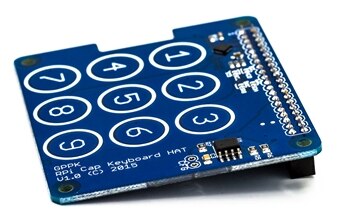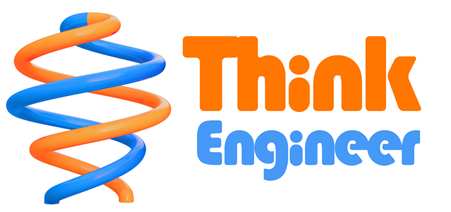Think Engineer is a team of product development specialists who produce bespoke electronics and software, providing clients with fully functional, high-tech prototypes. In 2016 they made the leap from client work to developing their own projects with the launch of CapHat - a Raspberry Pi capacitive keypad HAT accessory. They recently concluded a successful Kickstarter campaign, securing over £3,000 from backers to support further manufacturing and development of the product.
We spoke to Think Engineer co-founder Graham Kitteridge about their journey so far...
In a nutshell, what is Think Engineer?
Think Engineer was formed around bringing really cool ideas to life. We work with entrepreneurs and small businesses to produce bespoke prototypes using our skills in electronics, software and a whole range of other engineering disciplines.
How did Think Engineer come about?
The founders of Think Engineer all worked together in the research arm of a large engineering company. Whilst working there we learnt a lot about engineering process and how research fits into the larger development cycle. We decided that the part we really loved was working quickly and seeing demonstrators come alive. After an initial discussion in the pub and lots of “worst-case” planning we all quit on the same day and started Think Engineer.
Tell us about the CapHat project
The CapHat is a device which meets a small hole in the maker market of having a capacitive touch keypad for the Raspberry Pi. The CapHat has a regular number pad layout and can be programmed using Python within the Raspberry Pi Linux environment.
Was it always your intention to go from producing prototypes for clients to developing prototypes of your own?
Yes! Something that has been on our roadmap for a while is moving towards selling a range of development modules that meet gaps where other companies are not developing. We are especially interested in developing Machine Learning and Internet of Things development kits, as this is something we have a lot of experience with.
Tell us about the hardware and software you use for CapHat. How was it selected and developed? 
The hardware we use for the CapHat is rather simple, it features an MPR121 Capactive touch IC which is the main chip that communicates with the Raspberry Pi. This IC communicates over I2C to the Raspberry Pi and can then be communicated with using Python (or any other programming language). We will be releasing a set of example programs as well as open sourcing the hardware for users, so that they can have a look behind the scenes or build their own.
Why did you decide to go down the Crowd Funding route for CapHat?
At Think Engineer our customers are often seeking investment, planning (or have completed) crowdfunding campaigns and we wanted to understand the process from start to finish from a first-hand point of view. We have definitely learnt a lot about how to plan for a Kickstarter, through the actual campaign itself and eventually delivering the product.
Another reason that we went down the crowd funding route was so that we didn’t have to go out for investment to launch a new product, we could do it all via the Kickstarter.
Many crowdfunding campaigns fail at the first hurdle. To what do you attribute the success of the CapHat Kickstarter?
First off, we set a relatively low goal for the Kickstarter; we were specifically interested in covering all the costs of the Kickstarter itself, building the devices to ship & any marketing/advertising expenses.
The second thing that helped was having one large reward for any backer who wanted to invest more in the CapHat. This along with many education pledges really helped us get to our funding goal. We had a set of pledges such as “you buy one and we give one to a school” or similar, as the Raspberry Pi is something with a vested interest in education.
What are the biggest challenges you've faced so far?
The biggest challenge was getting the word out about the Kickstarter and driving traffic that would eventually turn into backers. Kickstarter are really helpful and push a lot of traffic through their featured sections, however we spent a lot of time over the 30 days really reaching out to our networks and asking for support
Why did you choose to develop a Raspberry Pi accessory for your first project?
The Raspberry Pi Foundation helpfully provide easy to follow specifications for Official HATs. This means that building something we can say is “official” was relatively easy and quite an exciting prospect. The CapHat itself meets a small market demand and we could manufacture them relatively easily.
What are the pros and cons of developing an accessory specifically aimed at an existing brand like Raspberry Pi?
The Raspberry Pi foundation is very supportive and provide lots of guidelines, we even reached out to them during the Kickstarter and they provided some helpful tips in addition to retweeting a few of our tweets. Another pro in developing for such a mainstream device is that there is a large market of people that would be potentially interested in backing or purchasing.
I’m not sure there are many cons to developing for the Raspberry Pi, however unlike developing a Shield for Arduino you do have to conform to their guidelines to call it an official HAT. One other con is that there are already a lot of accessories for the Raspberry Pi which meant being heard above the noise was a challenge we had to face when advertising etc.
Do you plan to continue to focus on Raspberry Pi for future products, or will you expand into other devices?
We work a lot with Arduino when we develop prototypes in-house, so we will definitely be launching some Arduino compatible devices in the future. With devices such as the Arduino Due & Zero there is such a large amount of processing power available there are so many things you can do! That being said we won’t be shying away from more Raspberry Pi accessories in the future, now that we understand the process for making official HATs this is definitely something we are interested in taking further.
What's the next step now that you've accomplished your initial crowdfunding goal?
Develop, Build & Ship! We have 75 backers waiting for their units and we don’t intend on disappointing. We have added the missing zero, sorted out a couple of other small issues and will be ordering prototypes to test before completing the large run of CapHats in the near future.
Where do you see Think Engineer twelve months from now?
We’ve just celebrated our One Year Anniversary, and things are definitely still on the up. We are really excited to be heading into our second year and are looking to expand our business and bring on-board more engineering talent as well as working with our customers to build more awesome devices.
What advice would you give to other start-ups in the engineering space who may be looking for opportunities to develop their project and take it to the market?
Don’t start tomorrow, start now. This might sound like a cliché, but there will always be a better time to start that business, build that product etc. If you’ve got a great idea and the ability to do something about it, start now. Hobbyist boards like the Raspberry Pi & Arduino mean that it has never been easier to develop something at home to prove your concept; it doesn’t need to be a lot to go on something like Kickstarter. If you can prove to a bunch of backers that if you had the cash you could make it happen, that’s all you need.

